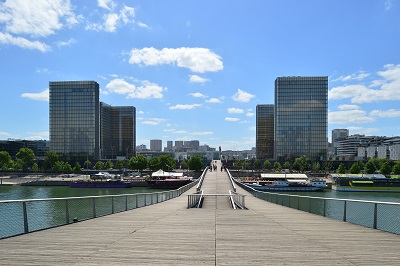The 27th
LaureateArchitecture
Dominique Perrault

Dominique Perrault is an architect who steeps himself in the history,environment,and special local nature of the construction site. His innovative buildings are designed to blend into the environment without spoiling those features. In 1989,he won the competition for the National Library of France (completed in 1995) at the age of 36. He buried the main body of the building underground and created a large a garden at its center. This innovative idea was severely criticized at first. However,one well-known architect who lost the competition praised Perrault’s design,and the library has gradually earned a positive reputation. The interior was designed by his partner,Gaëlle Lauriot-Prévost,who used “metal mesh” materials throughout. He was subsequently engaged in such major projects as the Velodrome and Olympic Swimming Pool in Berlin,the Court of Justice of the European Union in Luxembourg and the Albi Grand Theatre in Albi,France. Ongoing projects include the refurbishment of the Dufour Pavilion at the Palace of Versailles and the new Longchamp race track in Paris. In Japan,he designed the Noh Theatre in Tokamachi,Niigata Prefecture,Fukoku Tower in the Umeda business district of Osaka.
Biography
Dominique Perrault is an architect who primarily steeps himself in the history,environment,and special local nature of a building’s site before going to the drawing board to design it. His innovative buildings blend into the environment without spoiling those features. Well known for his unique ideas,he sometimes embeds his buildings deep in the ground and often uses the material of “metal mesh” as a key architectural feature in his works.
“My starting point is the empty space and how to design it,” Perrault explains. “We need empty spaces in our homes to make them livable. In the cityscape,this emptiness is sometimes viewed as positive,but sometimes as rather unsettling. My primary focus is on finding ways to enhance the quality of these empty spaces.”
Dominique Perrault’s answer to the philosophical dilemma of how to treat empty space is to build buildings in harmony with the special physical features of the locale and the historical background of the building site. He disagrees with the approach of some architects who seek to build eye-catching,unconventional buildings for their own sake.
“Architecture should not be closed on itself,with its back to the context. It should always be in resonance with the environment,whether natural or urban. We architects should always think about our buildings’ place in the urban design,and about the city itself as a whole.”
Dominique Perrault wanted to become a painter,but at the age of 25,he changed his orientation and decided to become an architect. In 1989,he won the competition of the National Library of France (completed in 1995) at the age of 36,by the decision of President Franҁois Mitterrand. He considers that the experience of painting has been useful in his work as an architect,but it has also been useful in a curious way in that he says,“it is something that has enabled me to lose the fear of looking at a blank page”.
The National Library of France,which brought him international renown as an architect,was full of innovative ideas. He built 100-meter towers at the four corners,buried the main body of the building underground and created: “At the heart of the library,a large garden; around it,a cloister,with towers,like an abbey.” This innovative design received severe criticism at first. However,one well-known architect who lost the competition praised Perrault’s design,and the library has gradually gained a positive reputation. The interior spaces are largely created by or clad in “metal mesh” materials designed by his partner,Gaëlle Lauriot-Prévost.
Since then,the two have worked together closely,engaged in such major projects as the Velodrome and Olympic Swimming Pool in Berlin,the Court of Justice of the European Union in Luxembourg and the Albi Grand Theatre,in Albi,France.
In the Albi Grand Theatre,they used the “metal mesh” previously used mainly for interior decoration,on the exterior,to drape and cover the entire building. The theatre manifests an evolving appearance as the day progresses. In the morning,the metal mesh shines like a golden scarf and in the evening the theatre glows in a soft,brick-red color,reflecting the light emanating from the interior through the metal mesh causing the building to blend with the beautiful street of the old town filled with houses made of local brick. At the same time,the mesh protects the building from the effects of the blazing sun of the south France sun and from rainstorms. Ongoing projects include the repurposing of the Dufour Pavilion in the Palace of Versailles and the new Longchamp race track in Paris.
Among his works in Asia,Dominique Perrault designed the Noh Theatre in Tokamachi,Niigata Prefecture,the Fukoku Tower in the Umeda business district of Osaka and the Ewha Women’s University Campus Center in Seoul,South Korea.
Chronology
Starts working as urban planner at the Atelier Parisien d’Urbanisme(APUR) of the city of Paris
Inauguration of the exhibition DPA Dominique Perrault Architecture at the Centre Georges Pompidou,Paris
Completion of Court of Justice of the European Union,Luxembourg
The exhibition DPA Dominique Perrault Architecture is presented at the Tokyo Opera City Art Gallery
Winner of the international competition for the Pavillon Dufour in Château de Versailles (completion 2016)
Completion of the 1st tower,DC Towers,Vienna,Austria
-

At National Library of France
-

National Library of France
-

Velodrome
-

Court of Justice of the European Union
-

Fukoku Tower
-

Albi Grand Theatre

